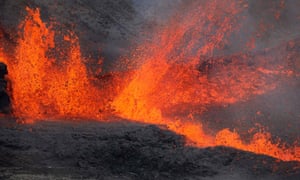Research offers ‘a sobering warning’ on the impact of today’s climate emergency
Volcanic eruptions
played an important and direct role in triggering the extreme climate
that killed off swathes of life at the end of the Triassic period 201m
years ago, researchers have found.
Experts say they have discovered bubbles of carbon dioxide trapped in volcanic rocks dating to the end of the Triassic, backing up the theory that such activity contributed to the greenhouse climate that is believed to have been behind the mass extinction.
“This biotic crisis wiped out almost half of the existing species of the late Triassic in both marine and terrestrial realms,” said Manfredo Capriolo of the University of Padova in Italy, a co-author of the study.
While Capriolo noted the end-Triassic mass extinction has long been known to have been caused by extreme climate change, and that there was large-scale volcanic activity at the time, he said it had been unclear whether the volcanic activity directly contributed to the extinction event. Among other possibilities, he said, it could have been that magma caused the emission of gases as it flowed into shallow sediments.
The new work, said Capriolo, shows that carbon dioxide released directly by volcanic activity would indeed have made a large contribution to the devastating climate change of the time.
Indeed the team say the amount of carbon emissions released in a single pulse of eruptions – which would have resulted in about 100,000 km3 of lava being spewed forth over 500 years – is on a par with the total expected to be produced by human activity over the 21st century, assuming a 2C rise in global temperature above pre-industrial levels.

Experts say they have discovered bubbles of carbon dioxide trapped in volcanic rocks dating to the end of the Triassic, backing up the theory that such activity contributed to the greenhouse climate that is believed to have been behind the mass extinction.
“This biotic crisis wiped out almost half of the existing species of the late Triassic in both marine and terrestrial realms,” said Manfredo Capriolo of the University of Padova in Italy, a co-author of the study.
While Capriolo noted the end-Triassic mass extinction has long been known to have been caused by extreme climate change, and that there was large-scale volcanic activity at the time, he said it had been unclear whether the volcanic activity directly contributed to the extinction event. Among other possibilities, he said, it could have been that magma caused the emission of gases as it flowed into shallow sediments.
The new work, said Capriolo, shows that carbon dioxide released directly by volcanic activity would indeed have made a large contribution to the devastating climate change of the time.
Indeed the team say the amount of carbon emissions released in a single pulse of eruptions – which would have resulted in about 100,000 km3 of lava being spewed forth over 500 years – is on a par with the total expected to be produced by human activity over the 21st century, assuming a 2C rise in global temperature above pre-industrial levels.

Capriolo stressed the similarity in CO2 levels was striking. “The end-Triassic world and the modern one are very different, as well as the origin of the greenhouse gas emissions, but we, as geoscientists, announce this alarming comparison,” he said.
Writing in the journal Nature Communications, Capriolo and colleagues report how they studied more than 200 samples of rock from North America, Morocco and Portugal. These were deposited towards the end of the Triassic, in volcanic activity that contributed to the breakup of the Pangea supercontinent and the opening up of the central Atlantic Ocean, with the rocks creating what is known as the Central Atlantic Magmatic Province – a vast expanse covering an area about a third of the size the moon.
The team found around 10% of the samples showed the presences of bubbles within small blobs of magma trapped by crystals in the rocks, most of which were found to contain carbon dioxide. Further analysis, they say, suggests the gas probably became entrapped deep within the Earth’s crust, suggesting it originated in the lower-middle crust or in the mantle.
From these findings the team were able to calculate the concentration of carbon dioxide that would have been present in the magma of the volcanic eruptions, revealing that up to 100,000 Gt of carbon dioxide would have been released in total as the volcanic rocks were laid down.
Dr Jessica Whiteside, associate professor of geochemistry at the University of Southampton who was not involved in the work, said the role of volcanic activity in the end-Triassic mass extinction had been a matter of much debate. “Over the past 30 years, the question as to whether widespread volcanic eruptions trigger climatic effects severe enough to result in extinction has waxed and waned, from most certainly no to most certainly yes,” she said.
The new study, she said, added weight to the latter view. “The study reports new evidence that is the most conclusive that has been produced for CO2 being emitted directly from individual lava eruptions relating to the Central Atlantic Magmatic Province,” she said, adding that the report reveals pulses of the eruptions spewed out amounts on a par to those produced by human activities, with devastating effects.
That, Whiteside added, provided lessons for today. “The initiation of these eruptions created one of the warmest climate since the dawn of animal life on our planet, and coincided with massive extinction on land and in the oceans,” she said.

No comments:
Post a Comment